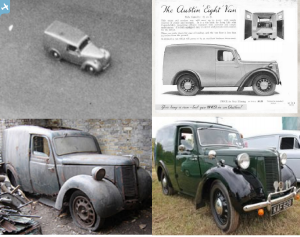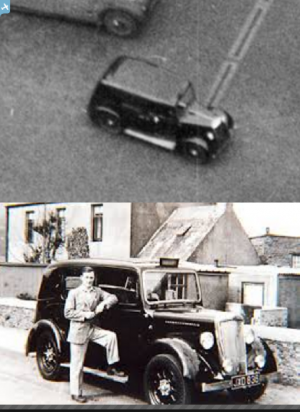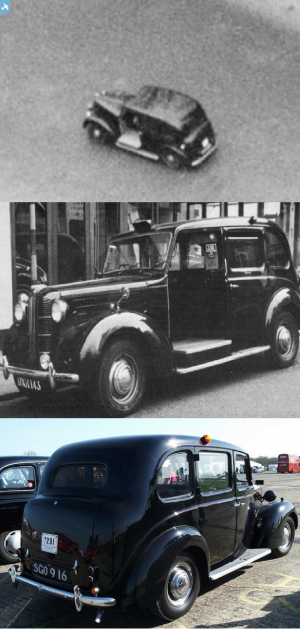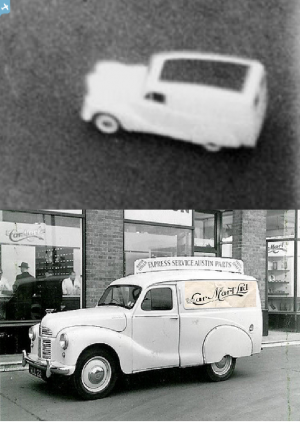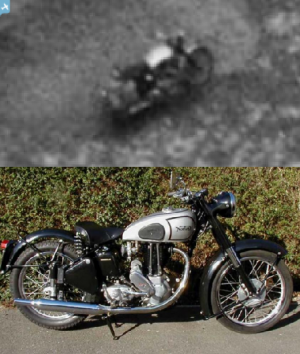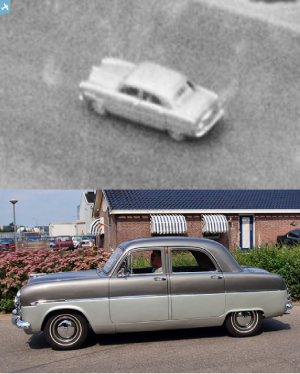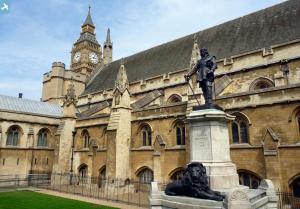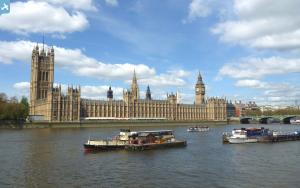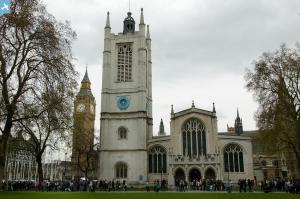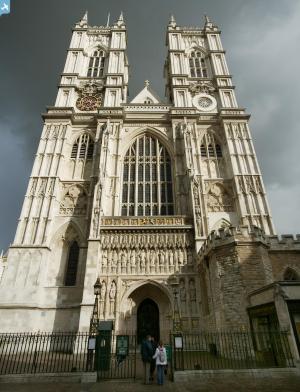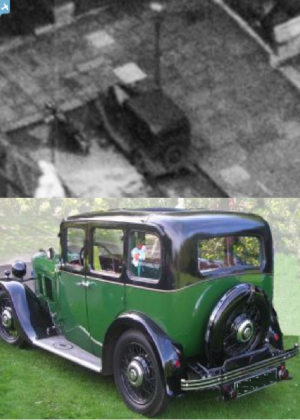  1935–1937 Morris Eight series I.
The car was powered by a Morris UB series 918 cc four-cylinder side-valve engine with three bearing crankshaft and single SU carburettor with maximum power of 23.5 bhp (17.5 kW). The gearbox was a three-speed unit with synchromesh on the top two speeds and Lockheed hydraulic brakes were fitted. Coil ignition was used in a Lucas electrical system powered by a 6 volt battery and third brush dynamo.
The body which was either a saloon or open tourer was mounted on a separate channel section chassis with a 7 feet 6 inches (2.29 m) wheelbase. The tourer could reach 58 mph (93 km/h) and return 45 miles per imperial gallon (6.3 L/100 km; 37 mpg-US); the saloons were a little slower. The chrome-plated radiator shell and honeycomb grille were dummies disguising the real one hidden behind. In September 1934 the bare chassis was offered for £95. For buyers of complete cars prices ranged from £118 for the basic two-seater to £142 for the four door saloon with "sunshine" roof and leather seats. Bumpers and indicators were £2 10 shillings (£2.50) extra. |
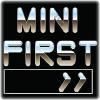
Billy Turner |
Saturday 19th of March 2016 04:04:37 PM |
 1939–1948 Austin 8 van. |

Billy Turner |
Saturday 19th of March 2016 03:17:09 PM |
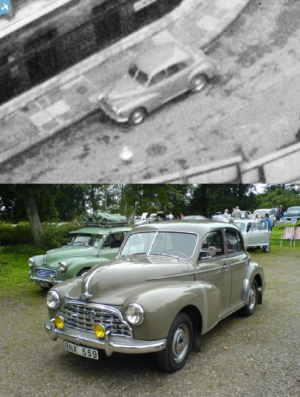  1948–54 Oxford MO
After the Second World War the 13.5 fiscal horsepower Oxford MO had to replace the Ten horsepower series M, Morris's Twelve and Morris's Fourteen. It was announced along with the new 918cc Minor and the 2.2-litre Six on 26 October 1948 and was produced until 1954. The design was shared with Nuffield Organisation stable-mate Wolseley 4/50 which used a traditional grille and better finishes.
Designed by Alec Issigonis, the Oxford, along with the Morris Minor, introduced unit construction techniques such as Unibody construction even though it is not widely recognized as a true unibody car. Torsion bar front suspension was another novelty, and hydraulically operated 8-inch (200 mm) drum brakes were fitted all around. Under the bonnet, the MO was a step back in technology from the pre-war Ten. It used a side-valve straight-4 rather than the older overhead-valve unit. The single SU-carburetted engine displaced 1.5 L (1476 cc/90 in3) and with its output of 40.5 bhp (30.2 kW) at 4200 rpm could propel the car to 72 mph (116 km/h). The four-speed gearbox had a column gear change and steering was by rack and pinion. |

Billy Turner |
Saturday 19th of March 2016 12:23:29 AM |
 1952–56 Morris Minor 2-door Series II.
In 1952, the Minor line was updated with an Austin-designed 803 cc (49.0 cu in) overhead valve A-series engine, replacing the original side-valve unit. The engine had been designed for the Minor's main competition, the Austin A30, but became available as Austin and Morris were merged into the British Motor Corporation. The new engine felt stronger, though all measurements were smaller than the old. The 52 second drive to 60 mph (97 km/h) was still calm, with 63 mph (101 km/h) as the top speed. Fuel consumption also rose to 36 miles per imperial gallon (7.8 L/100 km; 30 mpg. |

Billy Turner |
Saturday 19th of March 2016 12:20:45 AM |
 Nuffield Oxford Taxi.
The Nuffield Oxford Taxi, initially produced as the Wolseley Oxford Taxicab was the first new taxicab designed to comply with the Metropolitan Police Conditions of Fitness for London taxicabs to be launched on the British market after the end of the Second World War. |

Billy Turner |
Friday 18th of March 2016 10:00:36 PM |
 1948-58 Austin FX3 London Taxi.
The Austin FX3 is a taxicab that was sold in the United Kingdom by Austin from 1948 to 1958. It was designed to comply with the Metropolitan Police Conditions of Fitness for London taxicabs, but was used in other towns and cities in the UK. It was commissioned from Austin by taxi dealers Mann & Overton and built by Carbodies of Coventry on a chassis supplied by Austin. |

Billy Turner |
Friday 18th of March 2016 07:44:29 PM |
 1947-1952 Austin A40 Devon van. |

Billy Turner |
Friday 18th of March 2016 07:08:17 PM |
 1950 Norton ES2 motorcycle.
The ES2 is a Norton motorcycle first produced in 1927. It was a long stroke single, always 79mm x 100mm bore and stroke, originally launched as a sports motorcycle but throughout its long life it was gradually overtaken by more powerful models.
It remained popular due to its reliability and ease of maintenance, as well as the traditional design. From 1947 the ES2 had an innovative hydraulically damped telescopic front fork and race developed rear plunger suspension.
From 1953 it had a single downtube swinging-arm frame and was uprated to the Rex McCandless Featherbed frame in 1959, featuring an improved AMC gearbox, revised cylinder head, crankshaft-mounted Lucas RM15 60-watt alternator with coil ignition and an 8-inch front brake with full width hubs. The wideline Featherbed-framed bike was road tested by The Motor Cycle June 4, 1959 and found to have a mean top speed of 82 mph and with petrol consumption of 56 mpg at 60 mph. |

Billy Turner |
Friday 18th of March 2016 06:27:41 PM |
 Ford Zephyr Mark I.
The Ford Zephyr is a car that was manufactured by Ford of Britain from 1952 to 1972. Initially it was sold as a more powerful six-cylinder model to complement the four-cylinder Ford Consul and from 1962 the Zephyr itself was offered in both four- and six-cylinder versions, the Consul having been discontinued.
The Zephyr, and its luxury variants, the Ford Zodiac and Ford Executive, were the largest passenger cars in the British Ford range from 1951 until their replacement by the Consul and Granada models in 1972. |

Billy Turner |
Friday 18th of March 2016 05:17:19 PM |
 Oliver Cromwell |

Alan McFaden |
Tuesday 15th of July 2014 12:19:43 PM |
 Richard the Lionheart |

Alan McFaden |
Tuesday 15th of July 2014 12:18:47 PM |
 Houses of Parliament |

Alan McFaden |
Friday 6th of June 2014 12:05:32 PM |
 Saint Margaret's Church |

Alan McFaden |
Friday 6th of June 2014 12:04:48 PM |
 Westminster Abbey |

Alan McFaden |
Friday 6th of June 2014 12:04:09 PM |
 Westminster Abbey |

Alan McFaden |
Friday 6th of June 2014 12:03:37 PM |

















![[EAW048437] Temporary stands being erected outside Westminster Abbey for the Coronation of Queen Elizabeth II, Westminster, 1953](http://britainfromabove.org.uk/sites/all/libraries/aerofilms-images/public/100x100/EAW/048/EAW048437.jpg)
![[EAW048060] Westminster Abbey, Parliament Square and Clock Tower (Big Ben), Westminster, 1952](http://britainfromabove.org.uk/sites/all/libraries/aerofilms-images/public/100x100/EAW/048/EAW048060.jpg)
![[EPW005905] Westminster Abbey, Westminster, 1921. This image has been produced from a print.](http://britainfromabove.org.uk/sites/all/libraries/aerofilms-images/public/100x100/EPW/005/EPW005905.jpg)
![[EAW048435] Clock Tower (Big Ben) and temporary stands being erected outside Westminster Abbey for the Coronation of Queen Elizabeth II, Westminster, 1953](http://britainfromabove.org.uk/sites/all/libraries/aerofilms-images/public/100x100/EAW/048/EAW048435.jpg)
![[EAW048061] Westminster Abbey, Parliament Square and Clock Tower (Big Ben), Westminster, 1952](http://britainfromabove.org.uk/sites/all/libraries/aerofilms-images/public/100x100/EAW/048/EAW048061.jpg)
![[EPW006162] Westminster Abbey and environs, Westminster, 1921](http://britainfromabove.org.uk/sites/all/libraries/aerofilms-images/public/100x100/EPW/006/EPW006162.jpg)
![[EAW000524] The Houses of Parliament and Westminster Abbey, Westminster, 1946](http://britainfromabove.org.uk/sites/all/libraries/aerofilms-images/public/100x100/EAW/000/EAW000524.jpg)
![[EPW019024] Westminster Abbey, The Houses of Parliament and environs, Westminster, 1927](http://britainfromabove.org.uk/sites/all/libraries/aerofilms-images/public/100x100/EPW/019/EPW019024.jpg)
![[EAW048438] Temporary stands being erected outside Westminster Abbey for the Coronation of Queen Elizabeth II, Westminster, 1953](http://britainfromabove.org.uk/sites/all/libraries/aerofilms-images/public/100x100/EAW/048/EAW048438.jpg)
![[EAW048422] The erection of stands in preparation for the coronation of Queen Elizabeth II by Westminster Abbey, Westminster, 1953](http://britainfromabove.org.uk/sites/all/libraries/aerofilms-images/public/100x100/EAW/048/EAW048422.jpg)
![[EAW048062] Westminster Abbey and the surrounding area, Westminster, 1952](http://britainfromabove.org.uk/sites/all/libraries/aerofilms-images/public/100x100/EAW/048/EAW048062.jpg)
![[EAW048421] The erection of stands in preparation for the coronation of Queen Elizabeth II by Westminster Abbey, Westminster, 1953](http://britainfromabove.org.uk/sites/all/libraries/aerofilms-images/public/100x100/EAW/048/EAW048421.jpg)
![[EPW024749] Westminster Abbey and environs, Westminster, 1928](http://britainfromabove.org.uk/sites/all/libraries/aerofilms-images/public/100x100/EPW/024/EPW024749.jpg)
![[EAW000527] The Houses of Parliament, Westminster Abbey, nearby Government Offices and environs, Westminster, 1946](http://britainfromabove.org.uk/sites/all/libraries/aerofilms-images/public/100x100/EAW/000/EAW000527.jpg)
![[EAW049772] Temporary stands erected outside Westminster Abbey for the Coronation of Queen Elizabeth II, Westminster, 1953](http://britainfromabove.org.uk/sites/all/libraries/aerofilms-images/public/100x100/EAW/049/EAW049772.jpg)
![[EAW049015] Stands erected by Parliament Square and Westminster Abbey in preparation for the coronation of Queen Elizabeth II, Westminster, 1953](http://britainfromabove.org.uk/sites/all/libraries/aerofilms-images/public/100x100/EAW/049/EAW049015.jpg)
![[EAW049779] Temporary stands erected at Westminster Abbey and Parliament Square for the Coronation of Queen Elizabeth II, Westminster, 1953](http://britainfromabove.org.uk/sites/all/libraries/aerofilms-images/public/100x100/EAW/049/EAW049779.jpg)
![[EPR000211] The River Thames and surrounding city from the Houses of Parliament towards Blackfriars Bridge, Westminster, from the south-west, 1934](http://britainfromabove.org.uk/sites/all/libraries/aerofilms-images/public/100x100/EPR/000/EPR000211.jpg)
![[EPW019022] The Houses of Parliament, Westminster Abbey and environs, Westminster, 1927](http://britainfromabove.org.uk/sites/all/libraries/aerofilms-images/public/100x100/EPW/019/EPW019022.jpg)
![[EAW048063] Westminster Abbey and the surrounding area, Westminster, 1952](http://britainfromabove.org.uk/sites/all/libraries/aerofilms-images/public/100x100/EAW/048/EAW048063.jpg)
![[EAW048436] Temporary stands being erected outside Westminster Abbey for the Coronation of Queen Elizabeth II, Westminster, 1953](http://britainfromabove.org.uk/sites/all/libraries/aerofilms-images/public/100x100/EAW/048/EAW048436.jpg)
![[EAW043635] The Houses of Parliament, Westminster Bridge, Waterloo Station and environs, Westminster, from the west, 1952](http://britainfromabove.org.uk/sites/all/libraries/aerofilms-images/public/100x100/EAW/043/EAW043635.jpg)
![[EPR000412] Victoria Street, the Houses of Parliament and environs, Westminster, 1934. This image was marked by Aero Pictorial for photo editing.](http://britainfromabove.org.uk/sites/all/libraries/aerofilms-images/public/100x100/EPR/000/EPR000412.jpg)
![[EAW049403] The Houses of Parliament, St James's Park and environs, Westminster, 1953](http://britainfromabove.org.uk/sites/all/libraries/aerofilms-images/public/100x100/EAW/049/EAW049403.jpg)
![[EAW049016] Stands erected by Parliament Square and Westminster Abbey in preparation for the coronation of Queen Elizabeth II, Westminster, 1953](http://britainfromabove.org.uk/sites/all/libraries/aerofilms-images/public/100x100/EAW/049/EAW049016.jpg)
![[EAW049770] Clock Tower (Big Ben) and temporary stands erected around Parliament Square and Westminster Abbey for the Coronation of Queen Elizabeth II, Westminster, 1953](http://britainfromabove.org.uk/sites/all/libraries/aerofilms-images/public/100x100/EAW/049/EAW049770.jpg)
![[EAW049766] St Margaret's Church and temporary stands erected around Parliament Square for the Coronation of Queen Elizabeth II, Westminster, 1953](http://britainfromabove.org.uk/sites/all/libraries/aerofilms-images/public/100x100/EAW/049/EAW049766.jpg)
![[EAW049400] The Houses of Parliament, Parliament Square and environs, Westminster, 1953](http://britainfromabove.org.uk/sites/all/libraries/aerofilms-images/public/100x100/EAW/049/EAW049400.jpg)
![[EPW017272] The River Thames and the city, Westminster, from the south-west, 1926](http://britainfromabove.org.uk/sites/all/libraries/aerofilms-images/public/100x100/EPW/017/EPW017272.jpg)
![[EPW028627] The Houses of Parliament, St James's Park and environs, St James, 1929](http://britainfromabove.org.uk/sites/all/libraries/aerofilms-images/public/100x100/EPW/028/EPW028627.jpg)
![[EAW000525] The Houses of Parliament, Westminster Abbey and surrounding Government Offices, Westminster, 1946](http://britainfromabove.org.uk/sites/all/libraries/aerofilms-images/public/100x100/EAW/000/EAW000525.jpg)
![[EPW056680] Parliament Square and environs, Westminster, 1938](http://britainfromabove.org.uk/sites/all/libraries/aerofilms-images/public/100x100/EPW/056/EPW056680.jpg)
![[EAW043637] The Houses of Parliament, Westminster Bridge and Waterloo Station, Westminster, from the west, 1952](http://britainfromabove.org.uk/sites/all/libraries/aerofilms-images/public/100x100/EAW/043/EAW043637.jpg)
![[EPW006301] The Houses of Parliament, Westminster Abbey and Whitehall, Westminster, 1921](http://britainfromabove.org.uk/sites/all/libraries/aerofilms-images/public/100x100/EPW/006/EPW006301.jpg)
![[EAW033443] The Houses of Parliament and River Thames, Westminster, from the south-west, 1950](http://britainfromabove.org.uk/sites/all/libraries/aerofilms-images/public/100x100/EAW/033/EAW033443.jpg)
![[EPW021770] Westminster Abbey and the Houses of Parliament, Westminster, from the west, 1928](http://britainfromabove.org.uk/sites/all/libraries/aerofilms-images/public/100x100/EPW/021/EPW021770.jpg)
![[EAW021089] The Houses of Parliament and Westminster Abbey, Westminster, 1949. This image has been produced from a damaged negative.](http://britainfromabove.org.uk/sites/all/libraries/aerofilms-images/public/100x100/EAW/021/EAW021089.jpg)
![[EAW049017] Government Offices Great George Street and stands erected by Parliament Square and Westminster Abbey in preparation for the coronation of Queen Elizabeth II, Westminster, 1953](http://britainfromabove.org.uk/sites/all/libraries/aerofilms-images/public/100x100/EAW/049/EAW049017.jpg)
![[EAW048870] The Houses of Parliament and temporary stands erected outside Westminster Abbey for the Coronation of Queen Elizabeth II, Westminster, 1953](http://britainfromabove.org.uk/sites/all/libraries/aerofilms-images/public/100x100/EAW/048/EAW048870.jpg)
![[EAW043636] Westminster Abbey, the Houses of Parliament and the River Thames, Westminster, from the south-west, 1952](http://britainfromabove.org.uk/sites/all/libraries/aerofilms-images/public/100x100/EAW/043/EAW043636.jpg)
![[EAW043610] Parliament Square and environs, Westminster, 1952](http://britainfromabove.org.uk/sites/all/libraries/aerofilms-images/public/100x100/EAW/043/EAW043610.jpg)
![[EAW000523] The Houses of Parliament, Westminster Abbey and surrounding Government Offices, Westminster, 1946](http://britainfromabove.org.uk/sites/all/libraries/aerofilms-images/public/100x100/EAW/000/EAW000523.jpg)
![[EAW043636A] Westminster Abbey, the Houses of Parliament and the River Thames, Westminster, from the south-west, 1952](http://britainfromabove.org.uk/sites/all/libraries/aerofilms-images/public/100x100/EAW/043/EAW043636A.jpg)
![[EPW021769] Westminster Abbey and the Houses of Parliament, Westminster, from the west, 1928](http://britainfromabove.org.uk/sites/all/libraries/aerofilms-images/public/100x100/EPW/021/EPW021769.jpg)
![[EAW049758] Parliament Street and temporary stands erected at Parliament Square for the Coronation of Queen Elizabeth II, Westminster, 1953](http://britainfromabove.org.uk/sites/all/libraries/aerofilms-images/public/100x100/EAW/049/EAW049758.jpg)
![[EAW000476] The Houses of Parliament, Victoria Tower Garden and environs, Westminster, 1946. This image has been produced from a damaged negative.](http://britainfromabove.org.uk/sites/all/libraries/aerofilms-images/public/100x100/EAW/000/EAW000476.jpg)
![[EAW021090] Parliament Square and environs, Westminster, 1949. This image has been produced from a print.](http://britainfromabove.org.uk/sites/all/libraries/aerofilms-images/public/100x100/EAW/021/EAW021090.jpg)
![[EAW005242] The Foreign and Commonwealth Office, HM Treasury, The Palace of Westminster and environs, Westminster, from the north-west, 1947](http://britainfromabove.org.uk/sites/all/libraries/aerofilms-images/public/100x100/EAW/005/EAW005242.jpg)

